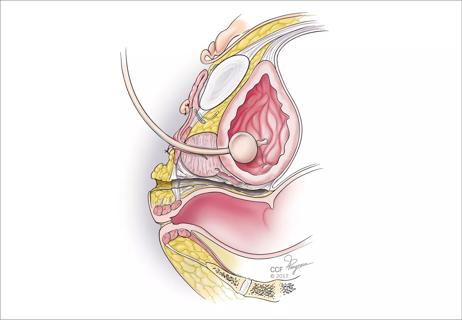Reducing opioids, increasing same-day discharge

Every surgeon wants to lower their patients’ post-operative complications, shorten their hospital stays, and reduce their readmission rates. Doing so improves patient outcomes and curtails health care costs.
Cleveland Clinic is a non-profit academic medical center. Advertising on our site helps support our mission. We do not endorse non-Cleveland Clinic products or services. Policy
With this in mind, two surgeons in Cleveland Clinic’s Female Pelvic Medicine and Reconstructive Surgery Fellowship are exploring methods for optimizing post-operative care for patients who are undergoing surgery for pelvic floor disorders.
Emily Davidson, MD, is conducting a randomized trial looking at whether reducing the number of opioids prescribed to women undergoing minimally invasive prolapse surgery would still effectively control their pain compared to women who receive the standard prescription for opioids.
Lisa Hickman, MD, is investigating whether using an Enhanced Recovery after Surgery (ERAS) protocol, designed to maintain pre-operative organ function and reduce the profound stress response following surgery, facilitates same-day discharge for patients undergoing sacrocolpopexy, a surgical procedure for repairing pelvic organ collapse.
“Strategies to decrease opioid abuse and enhance recovery after surgery are key initiatives in all surgical fields, especially urogynecology, since we have a growing aging population,” says Marie Fidela Paraiso, MD, Urogynecology and Reconstructive Pelvic Surgery, and senior investigator on both studies. “These surgeries are elective with the end goals of improving bulge and pressure symptoms for patients with pelvic organ prolapse as well as maintaining urinary, bowel and sexual function.”
Dr. Davidson was inspired to undertake her study based on two pieces of mail she received shortly after her fellowship began in July 2016. The first was a journal with an article detailing how surgeons were prescribing more opioids to urogynecology patients than they used. The second was a letter from Dr. Vivek Murthy — then-U.S. Surgeon General — calling on physicians to help fight the opioid epidemic. Dr. Davidson grew up in a small town in Indiana and knew many people that were affected by the painkiller epidemic.
“These two pieces of mail that arrived at the beginning of my research career really pushed me into thinking that we need to study this,” she says, “and that I need to be somebody who is not afraid to speak about this.”
Dr. Davidson proposed a randomized trial looking at reducing opioid prescriptions for urogynecology surgical patients with the primary outcome being patient satisfaction with pain control. Her cohort is women 18 years and older who are scheduled to undergo minimally invasive surgery within the urogynecology division at Cleveland Clinic with a plan to stay one night in the hospital afterward for a benign indication. Indications include vaginal hysterectomies with prolapse repair, sacrospinous ligament fixations, hysteropexy and sacrocolpopexy.
Patients in one arm of the study receive the standard opioid prescription of 28 tablets of oxycodone and patients in the other receive a prescription for five tablets of oxycodone. Upon discharge, patients also received information on the safe handling of opioids, how to dispose of them properly, and the potential for abuse and addiction. Dr. Davidson reports that the study has finally reached its recruitment goal.
“One barrier to conducting this research,” she says, “is that a significant number of women do not want to participate because they don’t want to take any opioids period… which I think is a sign that things are starting to turn in the right direction.”
Dr. Hickman’s research is focused on the use of ERAS in the urogynecology setting for patients undergoing sacrocolpopexy. The ERAS method uses published evidence for pre- and post-surgical care and challenges the traditional ideas of prolonged fasting, mobility limitations, mechanical bowel preparation, routine use of drains and the slow return to eating.
Dr. Hickman searched the gynecology literature and found that ERAS helps to facilitate same-day discharge home after surgery for gynecologic cancer patients. As a result, she decided to conduct a study looking at ERAS and same-day discharge for sacrocolpopexy.
Patients in the study watch a 10-minute education video on the surgery they’re having and what to expect before, during and after, the kinds of post-operative symptoms they could experience, and how to take their medicine. Postoperative medications are prescribed in advance to be filled prior to surgery.
Researchers review the patients’ charts to ensure they are appropriate candidates for going home, and ensure that a caregiver can be present at home for the first 24 hours after surgery. Patients receive oral medications on the morning of their surgery to help with pain control after their operation. The investigators also speak with the anesthesiologist about the importance of limiting narcotics as much as possible and judicious use of intravenous fluids.
At the end of surgery, patients also receive medication for pain control and nausea, and nurses are asked to turn off IV fluids as soon as the patient can take fluids by mouth. Patients are offered light foods and oral analgesic pain medications as soon as possible, which in turn helps to avoid IV analgesics.
If the patients can ambulate with assistance and have good pain control with oral medications, then they are sent home. Dr. Hickman calls patients the day after surgery and administers a survey that is repeated at their six week follow-up visit to assess the quality of their recovery. The study, which will eventually encompass 47 subjects, is ongoing. “Thus far,” Dr. Hickman says, “the majority of patients have appreciated being able to go home after surgery.”
“I think a lot of it is the mindset the patient comes to the hospital with and if you can empower them ahead of time with all the information on what to expect, then they feel prepared,” she says. “They’re thinking: ‘I’ll be sleeping in my own bed tonight and I’m going to take pain medication when I need it.’ People feel like it’s more restful and satisfying.”

Deprivation is linked to impaired glucose intolerance and racial disparities

Artesunate ointment is safe well and tolerated patients with vulvar intraepithelial neoplasia

A case-based discussion of efficacy, eligibility and use

Workshop curriculum was valued by some, while others would have preferred time for themselves

Study finds lower incidence of endometriosis than in cisgender patients

Large randomized study compares embryo growth kinetics and live birth rates between culture media

Surgeon experience is key to reducing adverse events

Introducing Laura Detti, MD, newly appointed Chair of the Department of Subspecialty Care for Women’s Health